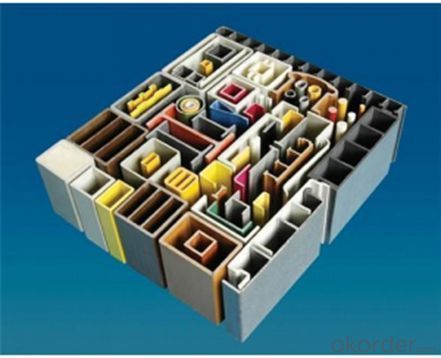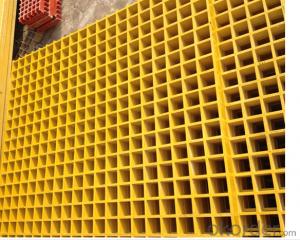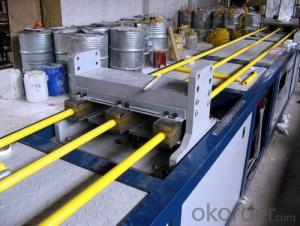FRP Pultrusion Profiles - Pultruded Grating Easy Installation & Maintenance
- Loading Port:
- Tianjin
- Payment Terms:
- TT OR LC
- Min Order Qty:
- 4000 watt
- Supply Capability:
- 100000 watt/month
OKorder Service Pledge
OKorder Financial Service
You Might Also Like
Specification
FRP PULTRUDED GRATING AND PULTRUSION PROCESS
PRODUCT DESCRIPTION
Pultruded grating is made by a particular assembly process, which using “I” shape as its main load-bearing and special rod to go through the bearing bar. Pultruded grating include the standard grating and the custom grating, the custom grating can be designed to meet customer’s requirement or special using condition by changing the shape, size and space of the bearing bars, the surface can be covered with lozenge panel, grit panel, or added the anti-slippery sand directly.
FRP pultruded grating has the most characteristics of molded grating, but it has its distinct advantages, it has very high fiberglass content in the loading direction, so it has very high load capability, it has more superiority when used at wide span, so that the basic support will be decreased and the project cost will be reduced accordingly.
SPECIFICATION
The standard space between two crossbars is 6 inch or 12 inch.
Thickness (mm) | Bar width (mm) | Open space (mm) | Open rate (%) | Approx weight (kg/m |
25.4 | 15.2 | 22.8 | 60 | 13.2 |
25.4 | 15.2 | 15.2 | 50 | 15.9 |
25.4 | 15.2 | 10.1 | 40 | 18.5 |
25.4 | 40 | 10.8 | 21 | 14.5 |
38.1 | 15.2 | 22.8 | 60 | 15.8 |
38.1 | 15.2 | 15.2 | 50 | 19.1 |
38.1 | 15.2 | 10.1 | 40 | 22.4 |
50.8 | 25.4 | 25.4 | 50 | 16.6 |
50.8 | 25.4 | 12.7 | 33 | 21.1 |
CHOICE FOR PULTRUDED GRATING
Resin: GP resin, ISO resin, VE resin, Phenol resin
Color choice: Yellow, gray, green, custom color
Surface choice: Groove surface, grit surface, lozenge cover surface
FEATURES
a. Anti-corrosion and anti-rust
b. Light weight and high strength
c. Anti-flammable
d. Anti- fatigue
e. Safe and anti-slippery
f. Anti-ageing
g. Easy of maintenance
h. Excellent electromagnetism property
i. Good economic benefit
FIELDS SERVED
Sewage treatment,
water supply and drainage,
chemical industry,
oil industry,
power engineering,
pulp and paper,
construction engineering,
spinning, marine engineering.
APPLICATION
Operation terrace,
stair walkway,
ground floor,
trench cover,
sidewalk,
foot bridge,
equipment safety fence,
scaffold.
COMPANT DESCRIPTION
CNBM,China National Building Materials Group is a state-owned enterprise in charge of administrative affairs in china building materials industry. Established in 1984, CNBM is a large group corporation of building materials with total assets of 25 billion RMB and a total staff of 30,000.CNBM now owns 200 subordinating firms of solely owned and joint-venture companies.
FAQ
1.Q:Are you factory or trading company ?
A:We are Factory produce FRP machines and FRP products.
2.Q:If can customized by customers requirements?
A:yes,we can produce the machine with customized size.
3.Q:How about the payment?
A:We accept any kind of payment.
4.Q:What is the guarantee?
A:Gurantee is one year.
5.Q:If you can training?
A:yes ,we can training in our factory also can send engineers to your factory training.
PICTURES


- Q: What are the different types of FRP pultrusion profiles available?
- There are several different types of FRP (Fiber Reinforced Polymer) pultrusion profiles available, each designed to meet specific application requirements and performance criteria. Some of the most common types include: 1. Standard shapes: These profiles are commonly used in various industries and applications. They come in a range of sizes and shapes, such as round tubes, square tubes, rectangular tubes, and angles. Standard shapes provide versatility and are suitable for a wide range of structural and non-structural applications. 2. Custom profiles: These profiles are specifically designed and manufactured according to customer specifications. Custom profiles offer greater flexibility in terms of shape, dimensions, and reinforcement options. They are often used in unique or specialized applications where standard shapes may not be suitable. 3. Structural profiles: These profiles are designed to provide high strength and stiffness properties. They are commonly used in load-bearing applications where structural integrity is crucial, such as beams, columns, and trusses. Structural profiles are reinforced with additional fibers to enhance their load-bearing capacity. 4. Electrical profiles: These profiles are designed to have excellent electrical insulation properties. They are commonly used in electrical and electronics applications, such as cable trays, busbars, and insulating supports. Electrical profiles offer high dielectric strength and resistance to electrical conductivity. 5. Environmental profiles: These profiles are specially formulated to resist harsh environmental conditions, such as extreme temperatures, UV radiation, or chemical exposure. They are commonly used in outdoor applications, such as structural supports, handrails, and grating systems. Environmental profiles provide long-term durability and resistance to degradation. 6. Fire-retardant profiles: These profiles are designed to have improved fire resistance properties. They are commonly used in applications where fire safety is a concern, such as building construction, transportation, and aerospace. Fire-retardant profiles are formulated with additives that inhibit flame spread and reduce smoke generation. It is important to note that these are just some of the common types of FRP pultrusion profiles available, and there may be other specialized profiles based on specific industry requirements. The selection of the appropriate profile depends on factors such as the intended application, load requirements, environmental conditions, and regulatory standards.
- Q: Are FRP pultrusion profiles resistant to impact from heavy machinery?
- Yes, FRP pultrusion profiles are highly resistant to impact from heavy machinery due to their inherent strength and durability. The strong composite materials used in their construction, such as fiberglass reinforced polymers, provide excellent impact resistance, making them a reliable choice for applications where heavy machinery might be involved.
- Q: Can FRP pultrusion profiles be used in electrical or telecommunications applications?
- Yes, FRP pultrusion profiles can be used in electrical or telecommunications applications. FRP (Fiber Reinforced Polymer) pultrusion profiles have excellent electrical insulation properties and are resistant to corrosion, making them suitable for use in electrical and telecommunications infrastructure. Additionally, their light weight, high strength, and design flexibility make them a desirable choice for applications such as cable trays, support structures, and enclosures in these industries.
- Q: Can FRP pultrusion profiles be used in the construction of train or subway platforms?
- Yes, FRP pultrusion profiles can be used in the construction of train or subway platforms. FRP (Fiber Reinforced Polymer) offers excellent strength, durability, and corrosion resistance, making it suitable for high-traffic areas like train or subway platforms. Additionally, FRP pultrusion profiles can be customized to meet specific design requirements, making them a versatile choice for platform construction.
- Q: Are FRP pultrusion profiles resistant to wear or abrasion?
- Yes, FRP (Fiber Reinforced Plastic) pultrusion profiles are highly resistant to wear and abrasion. The combination of the reinforcing fibers, typically glass or carbon, and the plastic resin matrix creates a material that is incredibly durable and can withstand heavy usage. The pultrusion process also ensures a homogeneous structure with fibers evenly distributed throughout the profile, further enhancing its resistance to wear and abrasion. Additionally, FRP pultrusion profiles can be engineered with specific additives or surface treatments to further enhance their resistance to wear and abrasion, making them suitable for a wide range of applications in various industries, such as construction, transportation, and marine.
- Q: Are FRP pultrusion profiles resistant to hydrochloric acid?
- Yes, FRP pultrusion profiles are generally resistant to hydrochloric acid due to the corrosion-resistant properties of the fiberglass reinforcement and the resin matrix used in their construction. However, the specific resistance may vary depending on the composition and concentration of the acid, and it is recommended to consult the manufacturer's specifications for detailed information regarding chemical resistance.
- Q: Are FRP pultrusion profiles suitable for the manufacturing of chemical reactors?
- Yes, FRP (Fiber Reinforced Polymer) pultrusion profiles are suitable for the manufacturing of chemical reactors. FRP pultrusion profiles offer several advantages that make them well-suited for this application. Firstly, FRP pultrusion profiles are highly corrosion-resistant, which is a critical characteristic for chemical reactors that are exposed to harsh chemicals. Unlike traditional materials like steel or concrete, FRP does not corrode or degrade when exposed to a wide range of chemicals, making it a reliable choice for chemical reactor construction. Secondly, FRP pultrusion profiles are lightweight yet strong, providing excellent structural integrity and durability. This allows for the construction of large-scale chemical reactors without adding excessive weight, reducing installation and transportation costs. Furthermore, FRP pultrusion profiles offer design flexibility, allowing for customization to meet specific requirements. They can be easily molded into various shapes and sizes, enabling the construction of complex reactor designs that optimize efficiency and performance. In addition, FRP pultrusion profiles have excellent thermal insulation properties, which can be advantageous in maintaining stable operating temperatures within chemical reactors. This can help improve the overall energy efficiency of the reactor and reduce heat loss. Overall, FRP pultrusion profiles are suitable for the manufacturing of chemical reactors due to their corrosion resistance, lightweight yet strong nature, design flexibility, and thermal insulation properties. These profiles offer a reliable and cost-effective solution for constructing chemical reactors that can withstand the demanding conditions of chemical processing.
- Q: Are FRP pultrusion profiles fire resistant?
- Yes, FRP pultrusion profiles are fire resistant.
- Q: Can FRP pultrusion profiles be used in the construction of playground equipment?
- FRP pultrusion profiles are indeed applicable in the construction of playground equipment. Renowned for their exceptional strength-to-weight ratio, resistance to corrosion, and long-lasting quality, these profiles prove to be ideal for outdoor applications like playground equipment. The versatility of these profiles allows for the creation of various structures such as slides, climbing frames, and play structures. Moreover, the ability to mold FRP pultrusion profiles into different shapes and sizes provides flexibility in design and customization options for playground equipment. An added advantage is that FRP materials are non-conductive, ensuring the safety of children. All in all, the numerous benefits offered by FRP pultrusion profiles make them an appropriate choice for constructing playground equipment.
- Q: Can FRP pultrusion profiles be used in the construction of pedestrian tunnels?
- Yes, FRP (Fiber Reinforced Polymer) pultrusion profiles can be used in the construction of pedestrian tunnels. FRP is a lightweight and high-strength material that offers numerous advantages over traditional construction materials like steel or concrete. One of the main advantages of using FRP pultrusion profiles in the construction of pedestrian tunnels is their corrosion resistance. Unlike steel, FRP does not corrode when exposed to moisture or harsh environmental conditions. This makes FRP profiles ideal for underground structures such as pedestrian tunnels where water seepage or high humidity can be a concern. Additionally, FRP pultrusion profiles have excellent mechanical properties, including high tensile strength and stiffness. This allows them to withstand heavy loads and provide structural integrity to the tunnel. The lightweight nature of FRP also makes it easier to handle and install, reducing the construction time and costs. Furthermore, FRP profiles can be easily molded into various shapes and sizes, making them highly versatile for designing pedestrian tunnels. They can be customized to meet specific project requirements, such as the curvature or dimensions of the tunnel. This flexibility in design allows for creative and efficient solutions in tunnel construction. In terms of safety, FRP pultrusion profiles have a high fire resistance and are non-conductive, which is crucial in ensuring the safety of pedestrians in tunnels. They also have a low thermal conductivity, providing insulation properties that can help maintain a comfortable environment inside the tunnel. Overall, the use of FRP pultrusion profiles in the construction of pedestrian tunnels offers numerous benefits, including corrosion resistance, high strength, versatility in design, and improved safety. These advantages make FRP an excellent choice for constructing durable and efficient pedestrian tunnels.
Send your message to us
FRP Pultrusion Profiles - Pultruded Grating Easy Installation & Maintenance
- Loading Port:
- Tianjin
- Payment Terms:
- TT OR LC
- Min Order Qty:
- 4000 watt
- Supply Capability:
- 100000 watt/month
OKorder Service Pledge
OKorder Financial Service
Similar products
Hot products
Hot Searches
Related keywords































